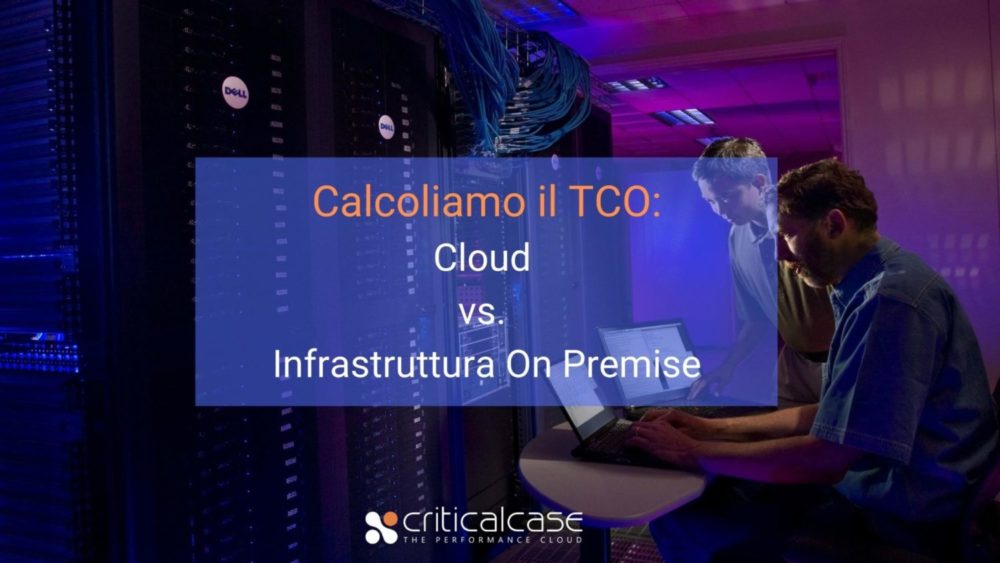CALCULATING THE TCO: CLOUD VS ON PREMISE INFRASTRUCTURE
TCO (Total Cost Of Ownership) is a financial estimate approved by Gartner in 1987 to help companies calculate precisely economic impact during the whole life cycle of IT projects.
Knowing the total costs allows companies to evaluate solutions and products more consciously than simply evaluating purchase price.
Migration to the cloud is an unstoppable trend, companies evaluate the advantages of cost-saving that a pay-as-you-go system offers when you need to replace your equipment on-premises, lower costs or switch to an agile model of business by developing cloud native applications.
Despite the growing trend, we still see how the decision-making process slows down due to complex cost calculations.

THE TCO IS WORTH MORE THAN THE PURCHASE PRICE
In front of a new IT project we ask ourselves the eternal question: should we buy the physical equipment or go in the Cloud direction.
To understand the long term economic impact that owning an infrastructure vs cloud services will have, it is necessary to correctly calculate the TCO.
Calculating the TCO for the on premise infrastructure, what should you consider?
Purchase of hardware and software:
- Costs for the purchase of servers
- Storage costs (SAN)
- Security devices (Firewall, Crypto Gateway, etc)
- Network
- Design and implementation of a backup plan
- IP
- Software licenses (Office package, Management, OS, DB, Antivirus and so on)
- Colocation in one or more datacenters
- If a disaster recovery plan is required, it is necessary to use 2 server farms at a distance of at least 50 km between them
Associated costs:
- Cost and time related to infrastructure design
- Costs of updates and improvements during the use
- Energy consumption and constant temperature monitoring
- Maintenance
- Technical support
- Staff training
- End of life disposal
- Inefficiency losses related to the over-dimensioning of the physical environment *
*during the design phase the resources are estimated roughly, therefore the proprietary hardware is used at approximately 60% of its capacity after being put into production
A quick look at the costs shows that some are one-off costs, such as the purchase of physical equipment, others are recurring costs (maintenance staff, colocation fee, energy consumption) that will occur throughout the whole period of use of the environment.
We recommend calculating the TCO for a 3-5 year period because the lifespan of physical equipment is about to end after 5 years of use.
After 3-5 years it will be necessary to evaluate the state of the hardware and place a budget for the entire purchase cost again to design a modern and performing infrastructure.
Cloud Infrastructure Costs
Cloud costs:
- Absence of Capital costs (CAPEX), it is replaced by a pay-as-you-go approach
- No maintenance costs, technical management is done by the Cloud service provider
- No risks associated with maintaining the infrastructure
Cloud convenience:
- Fast time-to-market: the provider will prepare the necessary environment in a very short time
- Ability to solve multiple tasks in a single platform
- Immediate scalability of resources as needed
- We only use Enterprise level hardware
- 24/7 assistance in Italian, English, German
Cloud performance and security:
- All the data are in one of our datacenters tier III and IV
- SLA guaranteed at 99.9998%
- Business continuity at zero cost
- Guaranteed security, protection against attacks
- High services performance, low latencies
To summarize, we should remember that the TCO consists of both design and implementation costs (CAPEX) as well as maintenance, electricity, and other day-to-day costs. By migrating to the Cloud there is a significant reduction of the total costs (TCO) by 20% based on 3 year period calculus and this economic convenience will become greater every year.
Criticalcase has been operating since 1999 as a High Availability Cloud provider, specializing in the provisioning of tailor-made full managed solutions. Additionally, Criticalcase is Autonomous System (AS48815), therefor it guarantees total flexibility of management and assignment of IP classes. Here you can read the detailed description of our Cloud architecture.
Contact us
Fill out the form and one of our experts will contact you within 24 hours: we look forward to meeting you!

